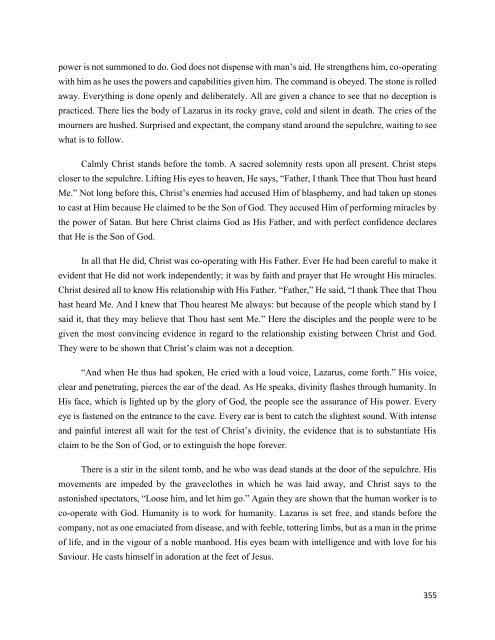- Page 2 and 3:
Information about this Book Overvie
- Page 4 and 5:
Table of Contents Information about
- Page 6 and 7:
Chapter 65—The Temple Cleansed Ag
- Page 8 and 9:
The angels of glory find their joy
- Page 10 and 11:
ecame flesh, and tabernacled among
- Page 12 and 13:
exalted. Our little world, under th
- Page 14 and 15:
from the Hebrews the meaning of the
- Page 16 and 17:
Chapter 3—“The Fullness of the
- Page 18 and 19:
The dying words of Jacob filled the
- Page 20 and 21:
demons that had controlled the will
- Page 22 and 23:
Augustus is made the agent for the
- Page 24 and 25:
Son, that the path of life might be
- Page 26 and 27:
of Egypt I hallowed unto Me all the
- Page 28 and 29:
the words spoken by the shepherds o
- Page 30 and 31:
Chapter 6—“We Have Seen His Sta
- Page 32 and 33:
“And thou Bethlehem, land of Juda
- Page 34 and 35:
years before, had been opened to th
- Page 36 and 37:
through a personal acceptance of Go
- Page 38 and 39:
By His own example He taught that i
- Page 40 and 41:
Chapter 8—The Passover Visit This
- Page 42 and 43:
the Jewish nation; but Jesus presen
- Page 44 and 45:
As His mission had opened to Jesus
- Page 46 and 47:
Chapter 9—Days of Conflict From i
- Page 48 and 49:
unbelief and contempt. They could n
- Page 50 and 51:
Mary often remonstrated with Jesus,
- Page 52 and 53:
Chapter 10—The Voice in the Wilde
- Page 54 and 55:
“Thou, child, shalt be called the
- Page 56 and 57:
perceptions were clear; he had deve
- Page 58 and 59:
soldiers, publicans, and peasants c
- Page 60 and 61:
destroyed. At the second advent of
- Page 62 and 63:
the heavens opened, and the Spirit
- Page 64 and 65:
mansions which Jesus has gone to pr
- Page 66 and 67:
knew the position that Christ had h
- Page 68 and 69:
There came to the Saviour, as if in
- Page 70 and 71:
sure of his prey. If we would meet
- Page 72 and 73:
consent to sin. Not even by a thoug
- Page 74 and 75:
had wrought marvelously for them; y
- Page 76 and 77:
walks by their side and says: Whate
- Page 78 and 79:
and all were eager to share in that
- Page 80 and 81:
When at the baptism of Jesus, John
- Page 82 and 83:
The disciple John was a man of earn
- Page 84 and 85:
The teaching of Christ was the expr
- Page 86 and 87:
As the guests assemble, many seem t
- Page 88 and 89:
As men set forth the best wine firs
- Page 90 and 91:
sanctioned the social gathering. A
- Page 92 and 93:
Chapter 16—In His Temple This cha
- Page 94 and 95:
service. He had given directions in
- Page 96 and 97:
Overpowered with terror, the priest
- Page 98 and 99:
In these words His meaning was twof
- Page 100 and 101:
Chapter 17—Nicodemus This chapter
- Page 102 and 103:
nothing that responds to spiritual
- Page 104 and 105:
give you, and a new spirit will I p
- Page 106 and 107:
was firm as a rock, encouraging the
- Page 108 and 109:
his bride, the mission of the frien
- Page 110 and 111:
Chapter 19—At Jacob’s Well This
- Page 112 and 113:
Jesus now abruptly turned the conve
- Page 114 and 115:
was already flashing into her mind.
- Page 116 and 117:
The Pharisees despised the simplici
- Page 118 and 119:
This woman represents the working o
- Page 120 and 121:
Christ was pained that His own peop
- Page 122 and 123:
Chapter 21—Bethesda and the Sanhe
- Page 124 and 125:
The Jews had so perverted the law t
- Page 126 and 127:
interpretation of the law was corre
- Page 128 and 129:
characters are to be builded “for
- Page 130 and 131:
whom God had sent. “Ye search the
- Page 132 and 133:
Chapter 22—Imprisonment and Death
- Page 134 and 135:
The Saviour did not at once answer
- Page 136 and 137:
or rank, or noble descent, or intel
- Page 138 and 139:
scene of music and dancing, and con
- Page 140 and 141:
the power of temptation. In this wa
- Page 142 and 143:
under the control of bigotry; their
- Page 144 and 145:
visitation. The years of the minist
- Page 146 and 147:
influence broke every barrier down;
- Page 148 and 149:
So angels protected Lot, and led hi
- Page 150 and 151:
Messiah. They questioned, If He was
- Page 152 and 153:
fisherman’s boat on the Sea of Ga
- Page 154 and 155:
Jesus chose unlearned fishermen bec
- Page 156 and 157:
Chapter 26—At Capernaum At Capern
- Page 158 and 159:
afflicted ones who came to Him felt
- Page 160 and 161:
withstood evil spirits. It was by t
- Page 162 and 163:
townsmen had tried to take His life
- Page 164 and 165:
The leper is guided to the Saviour.
- Page 166 and 167:
forth little response of love from
- Page 168 and 169:
forgiveness rests upon his spirit,
- Page 170 and 171:
Son, who had restored hope to the h
- Page 172 and 173:
e His co-labourer. When men appreci
- Page 174 and 175:
The disciples of John had not a cle
- Page 176 and 177:
of heaven. They thought their own r
- Page 178 and 179:
Chapter 29—The Sabbath The Sabbat
- Page 180 and 181:
Although the rabbis followed Him wi
- Page 182 and 183:
ecause of the loss to the owner if
- Page 184 and 185:
Chapter 30—“He Ordained Twelve
- Page 186 and 187:
opportunity of introducing them to
- Page 188 and 189:
not only a hearer but a doer of the
- Page 190 and 191:
Chapter 31—The Sermon on the Moun
- Page 192 and 193:
The worldling may pronounce this so
- Page 194 and 195:
of the thorn shall come up the fir
- Page 196 and 197:
equirements which hemmed in the Jew
- Page 198 and 199:
Him. Then true godliness will eleva
- Page 200 and 201:
is formed. The original loveliness
- Page 202 and 203:
Chapter 32—The Centurion This cha
- Page 204 and 205:
shall come from the east and west,
- Page 206 and 207:
Chapter 33—Who Are My Brethren? T
- Page 208 and 209:
empty, swept, and garnished. Then g
- Page 210 and 211:
His brothers often brought forward
- Page 212 and 213:
Christ offers depends upon conditio
- Page 214 and 215:
through Christ. The longer we are i
- Page 216 and 217:
Absorbed in their efforts to save t
- Page 218 and 219:
The disciples and their companions
- Page 220 and 221:
of Christ. Not one sermon from His
- Page 222 and 223:
Chapter 36—The Touch of Faith Thi
- Page 224 and 225:
mere intellectual assent to the tru
- Page 226 and 227:
Chapter 37—The First Evangelists
- Page 228 and 229:
them as divinely appointed teachers
- Page 230 and 231:
to false charges concerning the fai
- Page 232 and 233:
am I.” He uplifts the distressed
- Page 234 and 235:
Chapter 38—Come Rest Awhile This
- Page 236 and 237:
understand Him; to them He need not
- Page 238 and 239:
Chapter 39—“Give Ye Them to Eat
- Page 240 and 241:
In feeding the five thousand, Jesus
- Page 242 and 243:
The disciples were the channel of c
- Page 244 and 245:
Chapter 40—A Night on the Lake Th
- Page 246 and 247:
Unbelief was taking possession of t
- Page 248 and 249:
dependence upon Christ. Had he lear
- Page 250 and 251:
effort to provide for the life that
- Page 252 and 253:
Jesus did not attempt to explain th
- Page 254 and 255:
Jesus surrendered to the will of Go
- Page 256 and 257:
By the public rebuke of their unbel
- Page 258 and 259:
turned from Him might have carried
- Page 260 and 261:
in a special manner for His people,
- Page 262 and 263:
Chapter 43—Barriers Broken Down T
- Page 264 and 265:
household. As a child it is her pri
- Page 266 and 267:
Chapter 44—The True Sign This cha
- Page 268 and 269:
divine character. The greatest sign
- Page 270 and 271:
self-sacrifice, so slow to comprehe
- Page 272 and 273:
Sadly the disciples were forced to
- Page 274 and 275:
The Saviour did not commit the work
- Page 276 and 277:
It was to Peter a bitter lesson, an
- Page 278 and 279:
Chapter 46—He Was Transfigured Th
- Page 280 and 281:
was now fulfilled. Upon the mount t
- Page 282 and 283:
Chapter 47—Ministry This chapter
- Page 284 and 285:
Jesus turns to the suffering one, a
- Page 286 and 287:
Chapter 48—Who Is the Greatest? T
- Page 288 and 289:
giving occasion for misinterpretati
- Page 290 and 291:
Again Jesus explained to the discip
- Page 292 and 293:
partakers of My grace, in order to
- Page 294 and 295:
“Whatsoever ye shall bind on eart
- Page 296 and 297:
the white marble steps of the sacre
- Page 298 and 299:
which His Father had sent Him. He h
- Page 300 and 301:
those who heard Jesus were mourners
- Page 302 and 303:
which they professed to be defendin
- Page 304 and 305:
and compared written prophecy with
- Page 306 and 307: Impatient at His delay and apparent
- Page 308 and 309: Chapter 51—“The Light of Life
- Page 310 and 311: appearance and His work were so at
- Page 312 and 313: unchallenged, words that from any o
- Page 314 and 315: man sinned, nor his parents: but th
- Page 316 and 317: The Pharisees saw that they were gi
- Page 318 and 319: Chapter 52—The Divine Shepherd Th
- Page 320 and 321: “He that entereth in by the door
- Page 322 and 323: However much a shepherd may love hi
- Page 324 and 325: light and gladness to those darkene
- Page 326 and 327: were first to preach the gospel. Th
- Page 328 and 329: in their imagination. It is true th
- Page 330 and 331: fall upon the impenitent nation. Th
- Page 332 and 333: people. The Saviour’s words had s
- Page 334 and 335: eing in need and suffering. He took
- Page 336 and 337: Chapter 55—Not With Outward Show
- Page 338 and 339: and compromising Christianity. Not
- Page 340 and 341: Chapter 56—Blessing the Children
- Page 342 and 343: As the mother teaches her children
- Page 344 and 345: Chapter 57—“One Thing Thou Lack
- Page 346 and 347: strength and efficiency; for if the
- Page 348 and 349: Chapter 58—“Lazarus, Come Forth
- Page 350 and 351: During the two days Christ seemed t
- Page 352 and 353: godly,” 2 Peter 2:9. From every t
- Page 354 and 355: what passed as a demonstration of g
- Page 358 and 359: Chapter 59—Priestly Plottings Thi
- Page 360 and 361: ulers asked, “What do we?” Ther
- Page 362 and 363: Chapter 60—The Law of the New Kin
- Page 364 and 365: The one who stands nearest to Chris
- Page 366 and 367: Chapter 61—Zacchaeus This chapter
- Page 368 and 369: ancient Israel as well as for ourse
- Page 370 and 371: Chapter 62—The Feast at Simon’s
- Page 372 and 373: that Judas did not think essential
- Page 374 and 375: een so severely condemned, Christ h
- Page 376 and 377: Simon the host had been influenced
- Page 378 and 379: partaker of the divine nature. The
- Page 380 and 381: an independent nation. All were hap
- Page 382 and 383: that such noisy demonstrations were
- Page 384 and 385: through Him have been healed of her
- Page 386 and 387: Chapter 64—A Doomed People This c
- Page 388 and 389: Like the barren tree, they spread t
- Page 390 and 391: The prophets of God were hated by a
- Page 392 and 393: multitude of your sacrifices unto M
- Page 394 and 395: works throughout the land. He had h
- Page 396 and 397: Like the second son, who, when call
- Page 398 and 399: They must find a stone capable of r
- Page 400 and 401: the righteous is life, will be to t
- Page 402 and 403: of the Roman power, they should ren
- Page 404 and 405: The Sadducees reasoned that if the
- Page 406 and 407:
gained a broader view of the princi
- Page 408 and 409:
Chapter 67—Woes on the Pharisees
- Page 410 and 411:
He also reproved the vanity shown i
- Page 412 and 413:
should not be repulsed. Let them la
- Page 414 and 415:
The Pharisees built the tombs of th
- Page 416 and 417:
“Behold, your house is left unto
- Page 418 and 419:
would be given, “Let Him be cruci
- Page 420 and 421:
to the time when these words were s
- Page 422 and 423:
Chapter 69—On the Mount of Olives
- Page 424 and 425:
warned us of this, that we may not
- Page 426 and 427:
But the day and the hour of His com
- Page 428 and 429:
with the drunken, unites with the w
- Page 430 and 431:
Chapter 70—“The Least of These
- Page 432 and 433:
pampering pride and selfishness. Th
- Page 434 and 435:
Chapter 71—A Servant of Servants
- Page 436 and 437:
He poureth water into a basin, and
- Page 438 and 439:
After Christ had washed the discipl
- Page 440 and 441:
To those who receive the spirit of
- Page 442 and 443:
Christ is still at the table on whi
- Page 444 and 445:
Though Jesus knew Judas from the be
- Page 446 and 447:
eternal by the love of Jesus. And n
- Page 448 and 449:
Chapter 73—“Let Not Your Heart
- Page 450 and 451:
e uplifted by its restoring power.
- Page 452 and 453:
seeth Him not, neither knoweth Him:
- Page 454 and 455:
provided for His church. The Holy S
- Page 456 and 457:
saw in him a self-love and assuranc
- Page 458 and 459:
The life of the vine will be manife
- Page 460 and 461:
Lord: ... I will preserve Thee, and
- Page 462 and 463:
Chapter 74—Gethsemane This chapte
- Page 464 and 465:
Father, if it be possible, let this
- Page 466 and 467:
had come—that moment which was to
- Page 468 and 469:
y the Redeemer, “Whom seek ye?”
- Page 470 and 471:
Chapter 75—Before Annas and the C
- Page 472 and 473:
temptation to manifest His divine c
- Page 474 and 475:
Early in His ministry Christ had sa
- Page 476 and 477:
A high priest was not to rend his g
- Page 478 and 479:
Peter had not designed that his rea
- Page 480 and 481:
“Art Thou the Christ?” they sai
- Page 482 and 483:
thought, and take advantage of circ
- Page 484 and 485:
things he thought himself wiser tha
- Page 486 and 487:
mortal. But if He was the Son of Go
- Page 488 and 489:
the nation, bring to you a man they
- Page 490 and 491:
the conviction that pressed upon hi
- Page 492 and 493:
heard Him command the grave to give
- Page 494 and 495:
Even now Pilate was not left to act
- Page 496 and 497:
Christ’s enemies had demanded a m
- Page 498 and 499:
The greatest guilt and heaviest res
- Page 500 and 501:
Ten thousand times ten thousand, an
- Page 502 and 503:
from keeping the Passover. None eve
- Page 504 and 505:
their guilt; for it was their privi
- Page 506 and 507:
would utter upon this occasion. Yet
- Page 508 and 509:
given. “Today” while dying upon
- Page 510 and 511:
eholder would have been destroyed.
- Page 512 and 513:
When the loud cry, “It is finishe
- Page 514 and 515:
into sin. He could not discourage H
- Page 516 and 517:
love. Understanding the character o
- Page 518 and 519:
een apparent to heavenly beings tha
- Page 520 and 521:
lackness, and they stood accused by
- Page 522 and 523:
Yet they could not prevent it. They
- Page 524 and 525:
Nicodemus, when he saw Jesus lifted
- Page 526 and 527:
Command therefore that the sepulchr
- Page 528 and 529:
At the death of Jesus the soldiers
- Page 530 and 531:
The priests and rulers were in cont
- Page 532 and 533:
Chapter 82—“Why Weepest Thou?
- Page 534 and 535:
assurance that His atonement for th
- Page 536 and 537:
this hope, and it will hold the sou
- Page 538 and 539:
preparation, the chief priests and
- Page 540 and 541:
the Lord Jesus! He has risen from t
- Page 542 and 543:
“Behold, I stand at the door, and
- Page 544 and 545:
When Jesus first met the disciples
- Page 546 and 547:
Chapter 85—By the Sea Once More T
- Page 548 and 549:
is required. The reproach of the di
- Page 550 and 551:
known Christ after the flesh, as ma
- Page 552 and 553:
Chapter 86—Go Teach All Nations T
- Page 554 and 555:
garb of humanity, He had walked wit
- Page 556 and 557:
will touch invisible chords, whose
- Page 558 and 559:
It is in doing Christ’s work that
- Page 560 and 561:
soul, body, and spirit to God will
- Page 562 and 563:
Christ had sojourned in the world f
- Page 564 and 565:
This they say, not because they kno

















